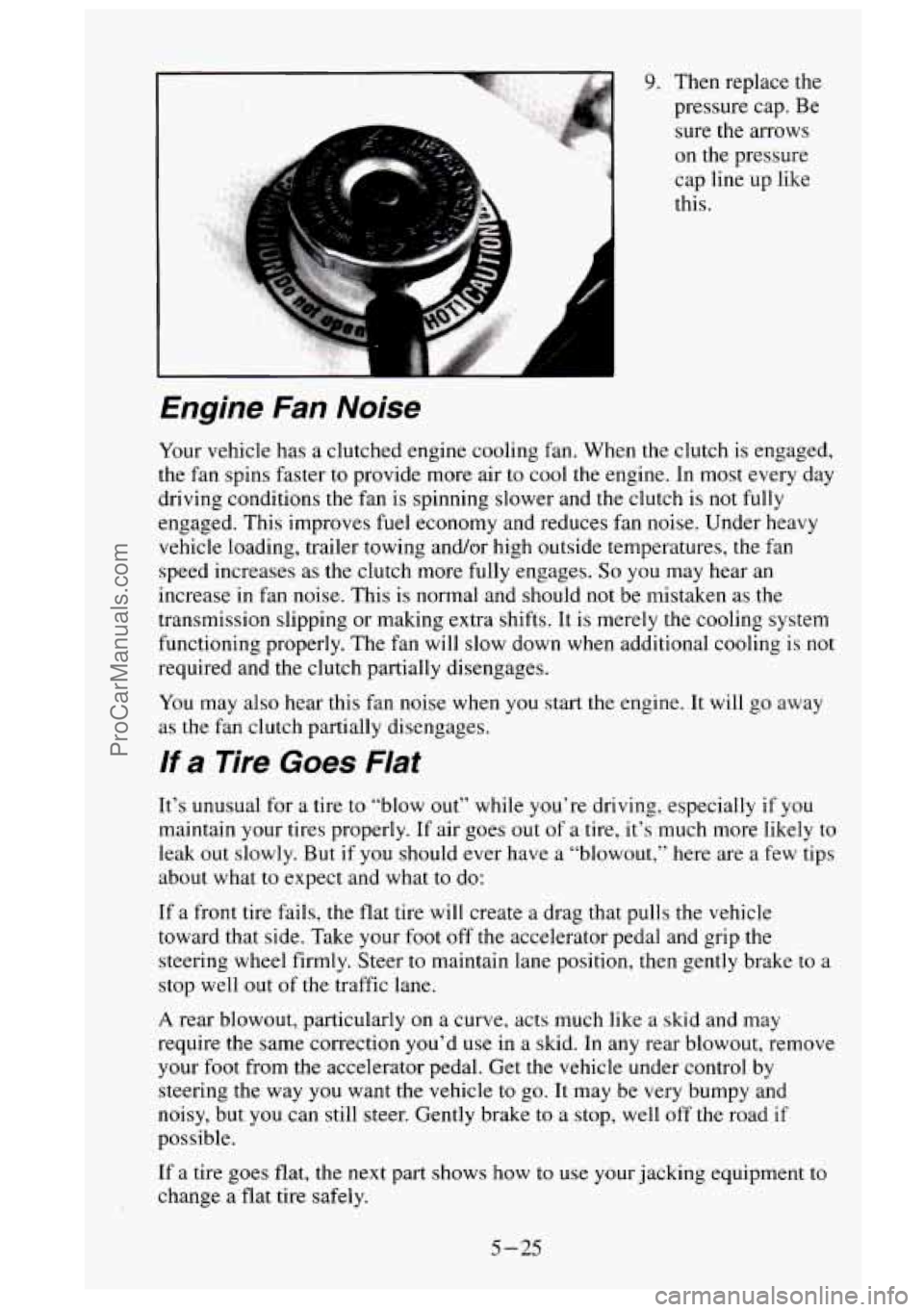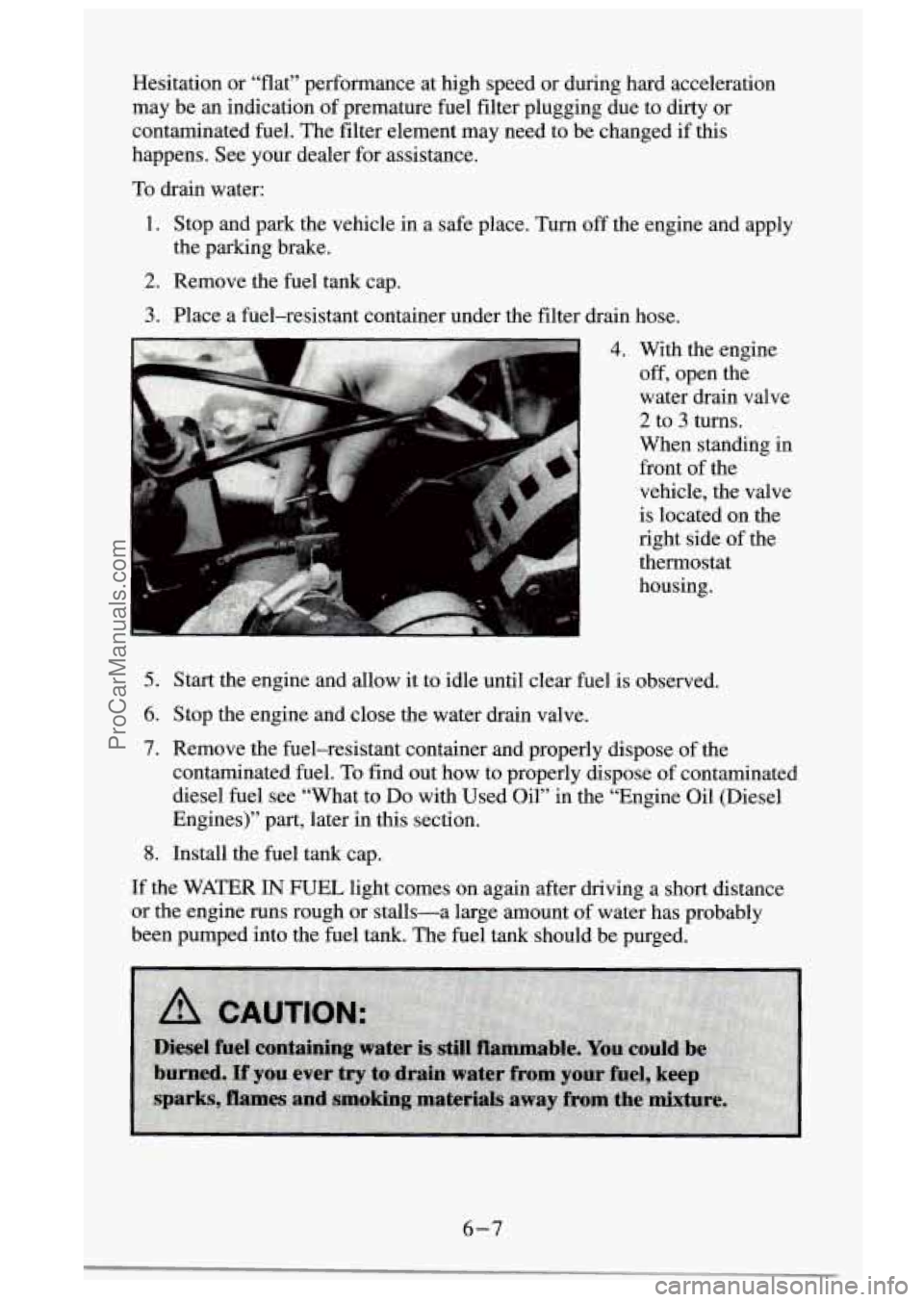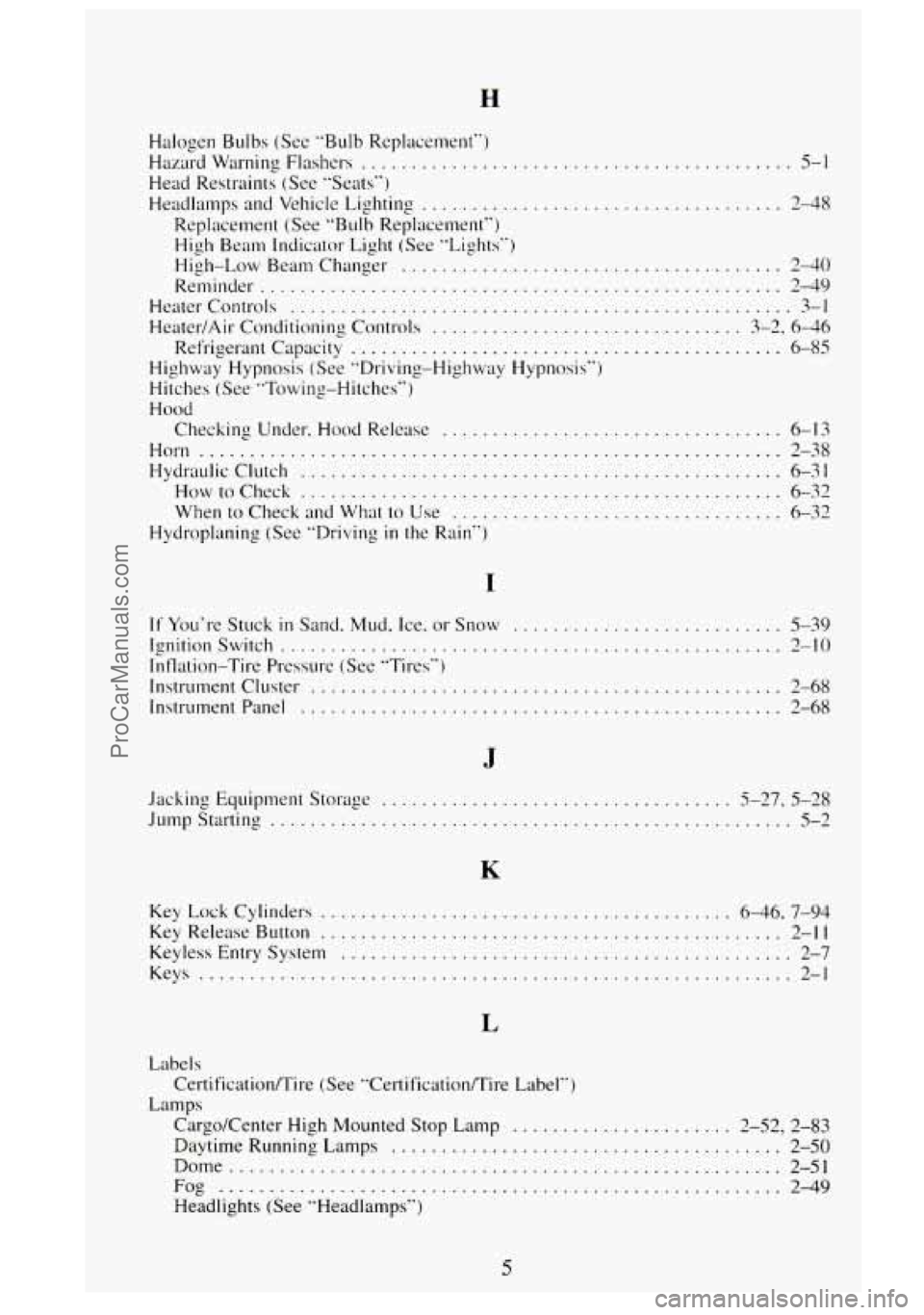Page 249 of 488

Engine Fan Noise
Your vehicle has a clutched engine cooling fan. When the clutch is engaged,
the fan spins faster
to provide more air to cool the engine. In most every day
driving conditions the fan is spinning slower and the clutch is
not fully
engaged. This improves fuel economy and reduces fan noise. Under heavy
vehicle loading, trailer towing and/or high outside temperatures, the fan
speed increases as the clutch more fully engages.
So you may hear an
increase
in fan noise. This is normal and should not be mistaken as the
transmission slipping or making extra shifts.
It is merely the cooling system
functioning properly. The fan will slow down when additional cooling is not
required and the clutch partially disengages.
You may also hear this fan noise when you start the engine. It will go away
as the
fan clutch partially disengages.
If a Tire Goes Flat
It’s unusual for a tire to “blow out” while you’re driving, especially if you
maintain your tires properly. If air goes out
of a tire, it’s much more likely to
leak out slowly. But if you should ever have a “blowout,” here are a few tips
about what to expect and what to do:
If a front tire fails, the flat tire will create a drag that pulls the vehicle
toward that side. Take your foot
off the accelerator pedal and grip the
steering wheel firmly, Steer
to maintain lane position, then gently brake to a
stop well out of
the traffic lane.
A rear blowout, particularly on a curve, acts much like a skid and may
require the same correction you’d use in a skid. In any rear blowout, remove
your
foot from the accelerator pedal. Get the vehicle under control by
steering the way
you want the vehicle to go. It may be very bumpy and
noisy, but you can still steer. Gently brake to a stop, well
off the road if
possible.
If a tire goes flat, the next part shows how to use your jacking equipment to
change a flat tire safely.
5-25
ProCarManuals.com
Page 270 of 488

Fuel Requirements
NOTICE:
Diesel fuel or fuel additives not recommended in this manual
could damage your fuel system and engine. Your warranty
wouldn’t cover this damage. And:
Diesel fuel that has been mixed with engine oil could damage
your engine and emission controls. Always check with your
service station operator to make sure his diesel fuel has not \
been mixed with engine oil.
If you ever run out of diesel fuel, it can be difficult to restart
your engine. “Running Out of Fuel,” later in this section, tells
you how to get it started again.
To avoid all this, try never to
let your tank get empty.
What Fuel to Use
For best results, use Number 2-D diesel fuel year-round (above and below
freezing conditionsj as oil companies blend Number
2-D fuel to address
climate differences. Number
1-D diesel fuel may be used in very cold
temperatures (when
it stays below 0°F or -18°C); however, it will produce
a power and fuel economy loss. The use of Number I-D diesel fuel in warm
or hot climates may result in stalling, poor starting when the engine is hot
and
may damage the fuel injection system.
Diesel fuel may foam when you
fill your tank. This can cause the automatic
pump nozzle to shut off, even though your tank isn’t
full. If this happens,
just wait for the foaming to stop and then continue to
fill your tank.
A CAUTION:
Heat coming from the engine may cause the fuel to expand and \
force the fuel out of your tank.
If something ignites the fuel, a
fire could start and people could be burned. To help avoid this,
fill your fuel tank only until the automatic nozzle shuts
off.
Don’t try to “top it off.”
6-4
ProCarManuals.com
Page 273 of 488

Hesitation or “flat” performance at high speed or during \
hard acceleration
may be an indication of premature fuel filter plugging due to dirty or
contaminated fuel. The fidter element may need to be changed
if this
happens. See your dealer for assistance.
To drain water:
1. Stop and park the vehicle in a safe place. Turn off the engine and apply
2. Remove the fuel tank cap.
the parking brake.
3. Place a
fuel-resistant container under the filter drain hose.
5.
6.
7.
8.
4. With the engine
off, open the
water drain valve
2 to 3 turns.
When standing in
front of the
vehicle, the valve
is located on the
right side of the
thermostat
housing.
Start the engine and allow it to idle until clear fuel is ob\
served.
Stop the engine and close the water drain valve.
Remove the fuel-resistant container and properly dispose of the
contaminated fuel.
To find out how to properly dispose of contaminated
diesel fuel see “What to Do with Used Oil” in the “E\
ngine Oil (Diesel
Engines)” part, later in this section.
Install the fuel tank cap.
If the WATER IN FUEL light comes on again after driving a short distance
or the engine runs rough or stalls-a large amount of water has probably
been pumped into the
fuel tank. The fuel tank should be purged.
6-7
ProCarManuals.com
Page 477 of 488

H
Halogen Bulbs (See "Bulb Replacement")
Hazard Warning Flashers
........................................... 5-1
Head Restraints (See "Seats")
Headlamps and Vehicle Lighting
.................................... 2-48
Replacement (See "Bulb Replacement")
High Beam Indicator Light (See "Lights")
High-Low Beam Changer
...................................... 240
Reminder .................................................... 2-49
Heater Controls .................................................. 3-1
Refrigerant Capacity ........................................... 6-85
Heater/Air Conditioning Controls ............................... 3-2 . 6-46
Highway Hypnosis (See "Driving-Highway Hypnosis")
Hitches (See "Towing-Hitches")
Hood
Checking Under: Hood Release .................................. 6-13
Horn .......................................................... 2-38
Hydraulic Clutch ................................................ 6-31
When to Check and What to Use ................................. 6-32
Howtocheck ................................................ 6-32
Hydroplaning (See "Driving in the Rain")
I
If You're Stuck in Sand . Mud. Ice . or Snow ........................... 5-39
Ignition Switch .................................................. 2-10
Intlation-Tire Prussure (See "Tires")
Instrument Cluster
............................................... 2-68
InstrumentPanel ................................................ 2-68
J
Jacking Equipment Storage ................................... 5-27 . 5-28
Jump Starting .................................................... 5-2
K
Key Lock Cylinders ......................................... 6-46.7-94
Key Release Button .............................................. 2-11
Keyless Entry System ............................................. 2-7
Keys
........................................................... 2-1
L
Labe 1 s
Lamps
Certification/Tire (See "CertificaticdTire Label")
CargdCenter High Mounted Stop Lamp
...................... 2.52, 2.83
Daytime Running Lamps ....................................... 2-50
Dome
....................................................... 2-51
Fog ........................................................ 2-49
Headlights
(See "Headlamps")
5
ProCarManuals.com